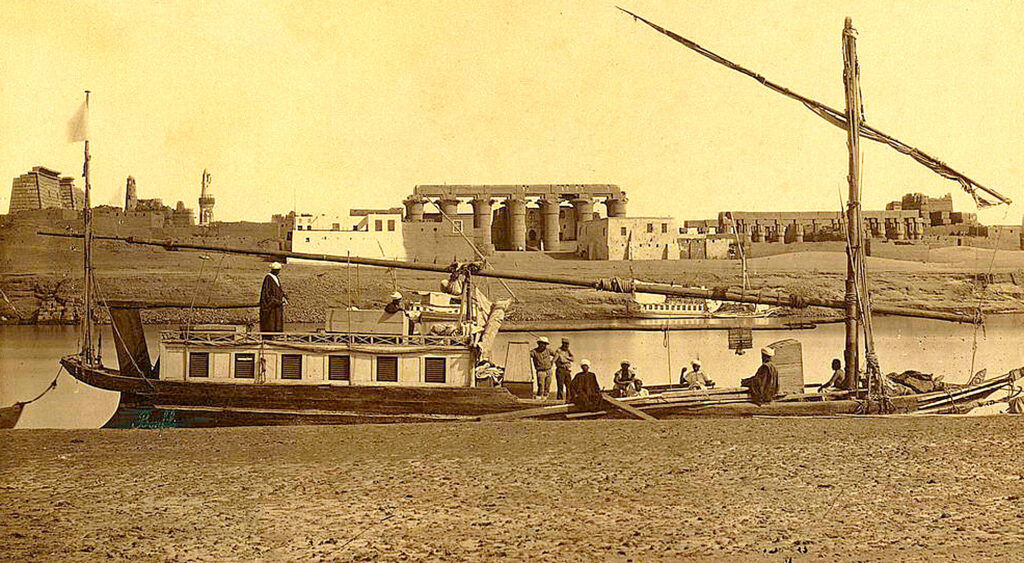The literal translation of the Arabic word dahabiya is the English word “Golden”. A dahabiya is a unique shallow draft boat that looks more like a barge than a boat and is propelled by the wind, river current or oars. It is a boat with an incredibly long history dating back thousands of years. Its name originates from the fact that the Egyptian pharaohs were known to have used gold-painted dahabiya to cruise the Nile River. There are drawings of similar boats on the walls of the tombs of pharaohs buried thousands of years ago.
Over the centuries it has come to be known by differently spelled names like dahabbeyah, dahbiah, dahabeah, dahblyah, dhahablyya, dahablyeh and dahabieh. Whatever spelling is used, it is a boat that has worked well on the Nile for a time in memoriam. Until the 1870s the dahabiya was the standard mode of transportation for tourist cruising on the Nile River. The famous travel agent, Thomas Cook and Sons created a package that attracted tourists from Europe and the United States. Their prearranged tours were safe, reliable, and relatively inexpensive and made it possible for un-chaperoned women to enjoy a tour.

In 1873 author Amelia Edwards was attracted to the Nile tour and wrote a book about the experience. In her book, A Thousand Miles up the Nile, she wrote:
“A dahabeeyah, at the first glance, is more like a civic or an Oxford University barge, than anything in the shape of a boat with which we in England are familiar. It is shallow and flat-bottomed and is adapted for either sailing or rowing. It carries two masts: a big one near the prow, and a smaller one at the stern. The cabins are on deck and occupy the after-part of the vessel; and the roof of the cabins forms the raised deck, or open-air drawing-room already mentioned. This upper deck is reached from the lower deck by two little flights of steps and is the exclusive territory of the passengers. The lower deck is the territory of the crew. A dahabeeyah is, in fact, not very unlike the Noah’s Ark of our childhood, with this difference – the habitable part, instead of occupying the middle of the vessel, is all at one end, top-heavy and many-windowed; while the fore-deck is not more than six feet above the level of the water. The hold, however, is under the lower deck, and so counterbalances the weight at the other end. Not to multiply comparisons unnecessarily, I may say that a large dahabeeyah reminds one of old pictures of the Bucentaur, especially when the men are at their oars.
The kitchen – which is a mere shed like a Dutch oven in shape and contains only a charcoal stove and a row of stew pans – stands between the big mast and the prow, removed as far as possible from the passengers’ cabins. In this position the cook is protected from a favorable wind by his shed; but in the case of a contrary wind, he is screened by an awning. How, under even the most favorable circumstances, these men can serve up the elaborate dinners which are the pride of a Nile cook’s heart, is sufficiently wonderful; but how they achieve the same results when wind-storms and sand-storms are blowing, and every breath is laden with the fine grit of the desert, is little short of miraculous.
Thus far, all dahabeeyahs are alike. The cabin arrangements differ, however, according to the size of the boat; and it must be her upper deck at the broadest part a little short of twenty.
Her book was widely read and is credited with having created a great interest in touring the Nile that proved to be very profitable for the firm of Thomas Cook and Sons. Tourists discovered the Nile and the treasures that could be reached from its shores by way of a Thomas Cook-arranged tour onboard a dahabiya.
The family of the sickly boy who one day would become president of the United States, Theodore Roosevelt, booked a tour in October of 1872. The family journeyed abroad for a second time partly for the adventure and partly to ease the chronic asthma condition of young Teddy Roosevelt. The boat they rented was the Aboul Irdan (Ibis in English). It had a crew of thirteen and afforded the Roosevelts all the comforts and luxury of a resort. Teddy Roosevelt described it as: “the nicest, coziest, pleasant little place you ever saw.”
Over a period of two months, the Roosevelt party traveled nearly twelve hundred miles as part of a convoy of the dahabiya boats. In addition to their boat, there was a boat rented by Mr. and Mrs. Smith Clift of New York and their two young daughters, their boat was called the Gazelle. The other boat called the Rachel was rented by four young vacationing Harvard students. At a stop during the trip, by chance, Theodore Roosevelt encountered the famed poet Ralph Waldo Emerson who was also touring the Nile with his family.
The trip up the Nile to Aswan might take several weeks because of the variables of wind and the ever-present danger of going aground on a sandbar. When that occurred, the crew would have to get into the water and pull the boat into deeper water.
Thomas Cook and Son’s created what they called the Nile Flotilla. As word spread of the joys of travel on the Nile spread, hotels were opened on the route. Thomas Cook built the Old Cataract Hotel at Aswan in 1899 and the winter Palace Hotel in Luxor in 1907. The discovery of the tomb of Tutankhamun in 1922 further increased the tourist visits to Luxor.
Touring the Nile River in a dahabiya is now more popular than ever. there are several companies providing sailing dahabiyas with all of the traditional luxury they can provide. It is a unique and memorable experience.
